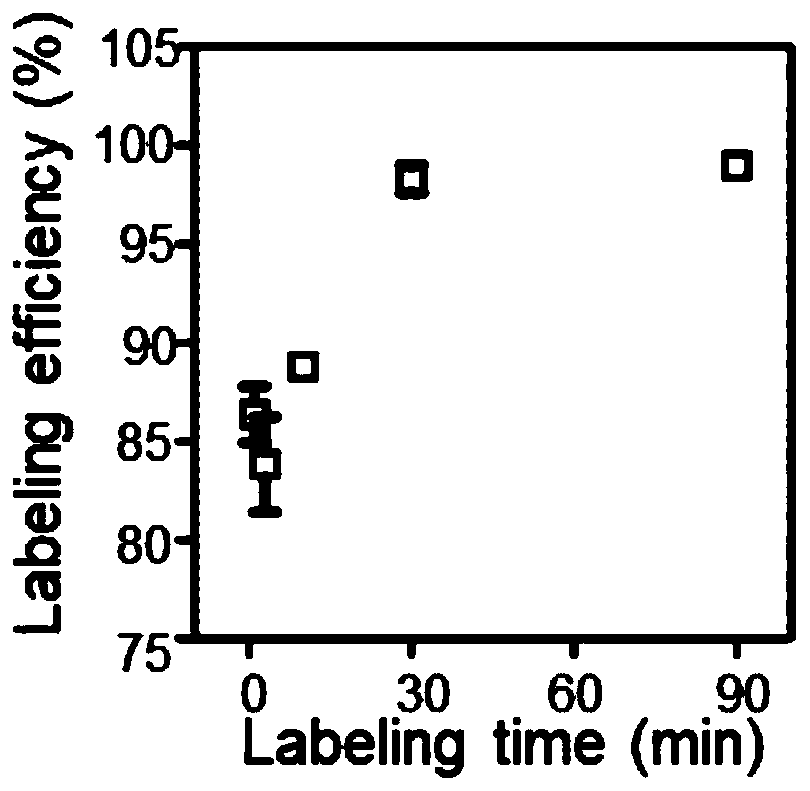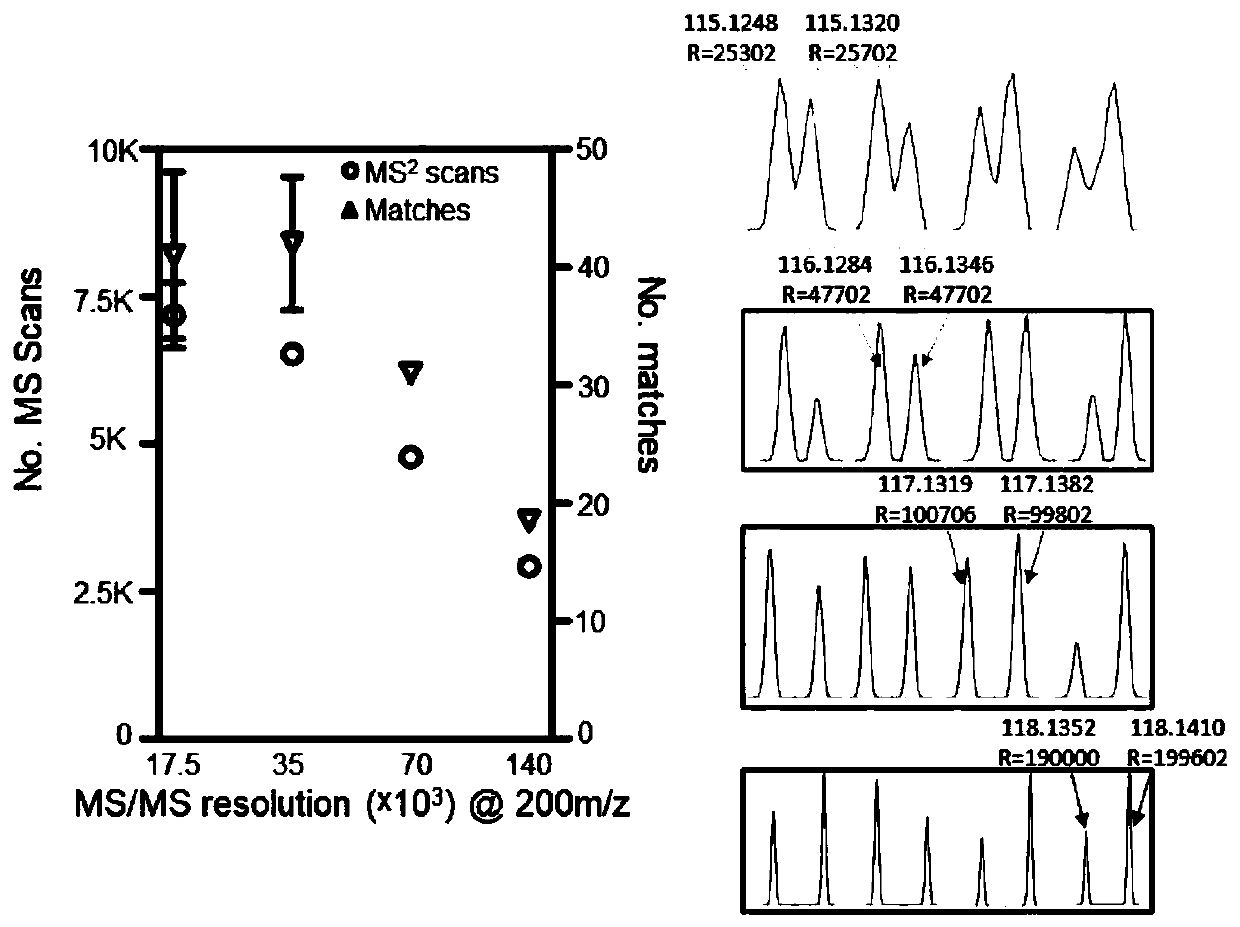Stable isotope-based high-throughput proteomic quantitative reagent
A stable isotope and isotope technology, applied in measurement devices, scientific instruments, instruments, etc., can solve the problems of high price, laboratory economic burden and application barriers, and achieve the effect of improving yield, low cost and reducing cost
- Summary
- Abstract
- Description
- Claims
- Application Information
AI Technical Summary
Problems solved by technology
Method used
Image
Examples
Embodiment 1
[0076] Embodiment 1: Synthesis of T-114 in IBT-10PLEX (structure A), the synthetic route is as follows:
[0077]
[0078] Synthesis of T-114 in IBT-10PLEX (structure A), the asterisks in the synthetic route represent 13C or 15N at the corresponding positions. This route can be used for the synthesis of T-114, T-115N, T-115C, T-116N, T-116C, T-117N, T-118N in IBT-10PLEX (structure A).
[0079] Compound 1 (β-Ala-OBzl.HCl, 13C3, 15N, 215 mg, 1 mmol) and compound 2 (Boc-Gly-OH, 1-13C, 175 mg, 1 mmol) were dissolved in 20 mL of dichloromethane, and EDC.HCl ( 229 mg, 1.2 mmol), the reaction was carried out under the protection of argon for 20 hours, the reaction solution was washed three times with 30 mL of 25 mM dilute hydrochloric acid, and the organic phase was dried and removed by a rotary evaporator to obtain 283 mg of oily compound 3 (84% yield). Compound 3 (283 mg) was added to 50 mL of HCl in EtOAc (1 M) and stirred for 2 hours, the resulting white precipitate was collec...
Embodiment 2
[0080] Embodiment 2: Synthesis of T-119 in IBT-10PLEX (structure A), the synthetic route is as follows:
[0081]
[0082] Synthesis of T-119 in IBT-10PLEX (structure A), the asterisks in the synthetic route represent 13C or 15N at the corresponding positions. This route can be used for the synthesis of T-117C, T-118C, T-119 in IBT-10PLEX (structure A).
[0083] Compound 8 (Nosyl-Gly-OH, 15N, 2-13C, 524mg, 2mmol) was dissolved in 10mL DMF, solid sodium carbonate (636mg, 6mmol) and iodopropane (590μL, 1.02g, 6mmol) were added, stirred for 1 hour, The white solid was filtered, and most of the DMF was removed by rotary evaporation, 30 mL of dichloromethane was added, washed 3 times with 20 mM aqueous sodium bicarbonate solution and 50 mL of saturated brine, respectively, and the dichloromethane was removed to obtain 654 mg of white compound 9 (95% yield). Compound 9 (654 mg) was dissolved in 20 mL of KOH / MeOH saturated solution, 400 μL of 2-mercaptoethanol was added, and the r...
Embodiment 3
[0085] Embodiment 3: Synthesis of T-114 in IBT-10PLEX (structure B), the synthetic route is as follows
[0086]
[0087] Synthesis of T-114 in IBT-10PLEX (structure B), the asterisks in the synthetic route represent 13C or 15N at the corresponding positions. This route can be used for the synthesis of all 10 reagents in IBT-10PLEX (structure B).
[0088] Compound 1 (β-Ala-OBzl.HCl, 13C3, 15N, 172mg, 0.8mmol) and compound 2 (Boc-Gly-OH, 1-13C, 140mg, 0.8mmol) were dissolved in 20mL of dichloromethane, and EDC was added. HCl (183mg, 0.96mmol), the reaction was carried out under the protection of argon for 20 hours, the reaction solution was washed three times with 30mL of 25mM dilute hydrochloric acid, and the organic phase was dried and removed with a rotary evaporator to obtain 242mg of oily compound 3 (90% yield) . Compound 3 (242 mg) was added to 50 mL of HCl in EtOAc (1 M) and stirred for 2 hours, the resulting white precipitate was collected by filtration to give 160 ...
PUM
 Login to View More
Login to View More Abstract
Description
Claims
Application Information
 Login to View More
Login to View More - R&D
- Intellectual Property
- Life Sciences
- Materials
- Tech Scout
- Unparalleled Data Quality
- Higher Quality Content
- 60% Fewer Hallucinations
Browse by: Latest US Patents, China's latest patents, Technical Efficacy Thesaurus, Application Domain, Technology Topic, Popular Technical Reports.
© 2025 PatSnap. All rights reserved.Legal|Privacy policy|Modern Slavery Act Transparency Statement|Sitemap|About US| Contact US: help@patsnap.com



